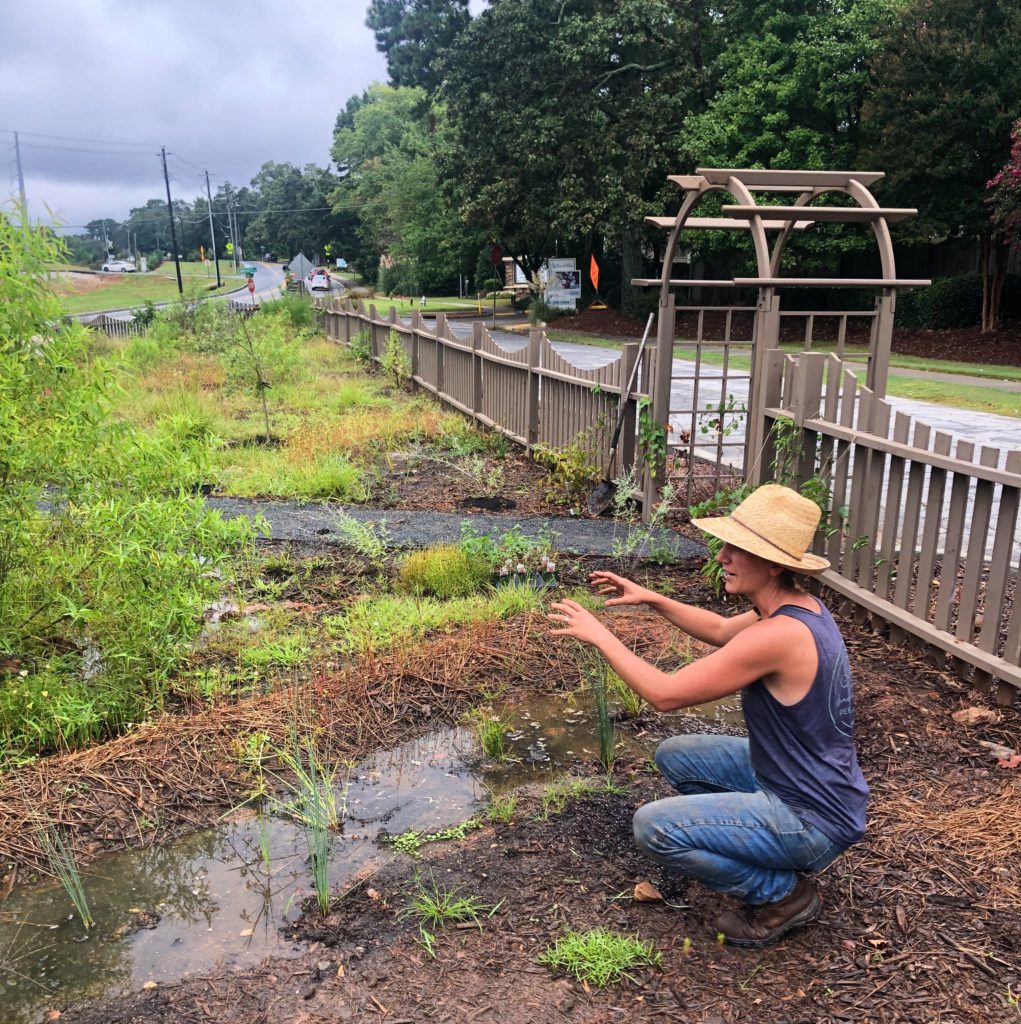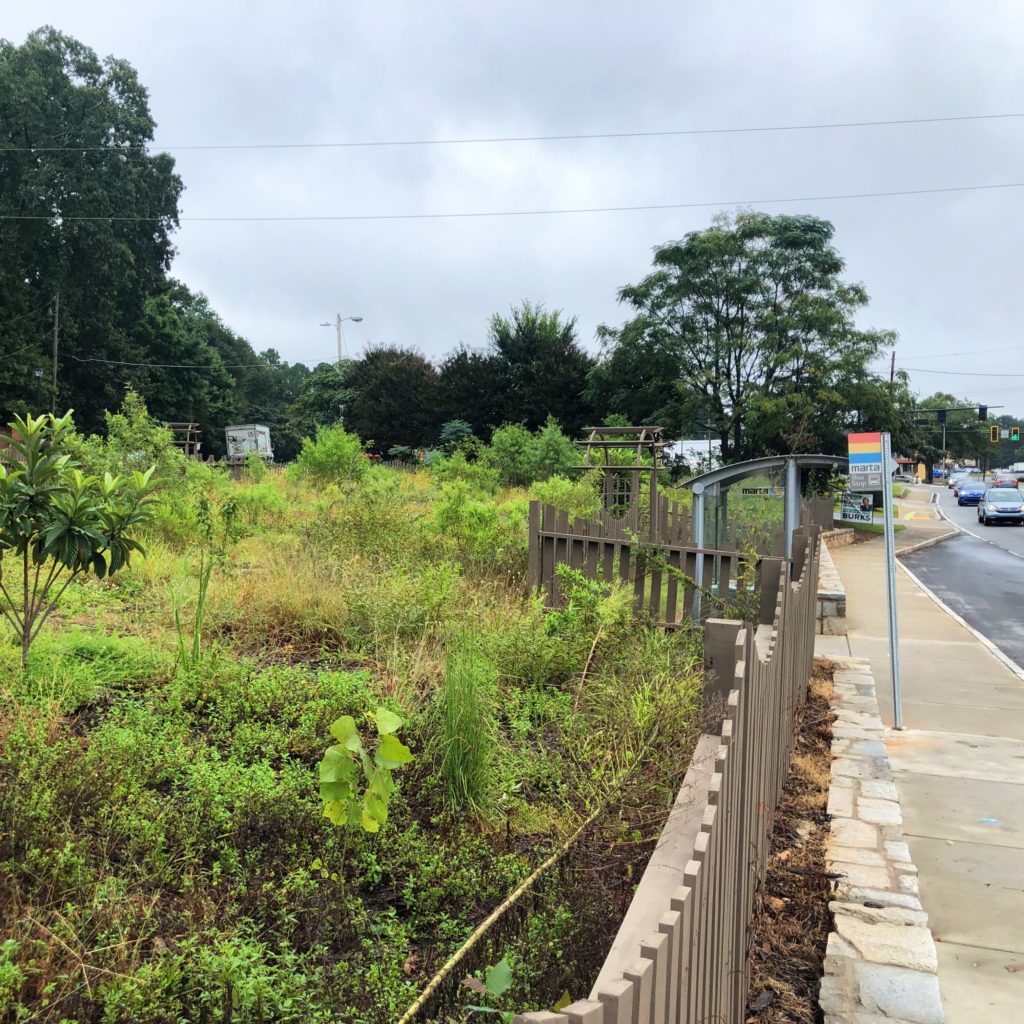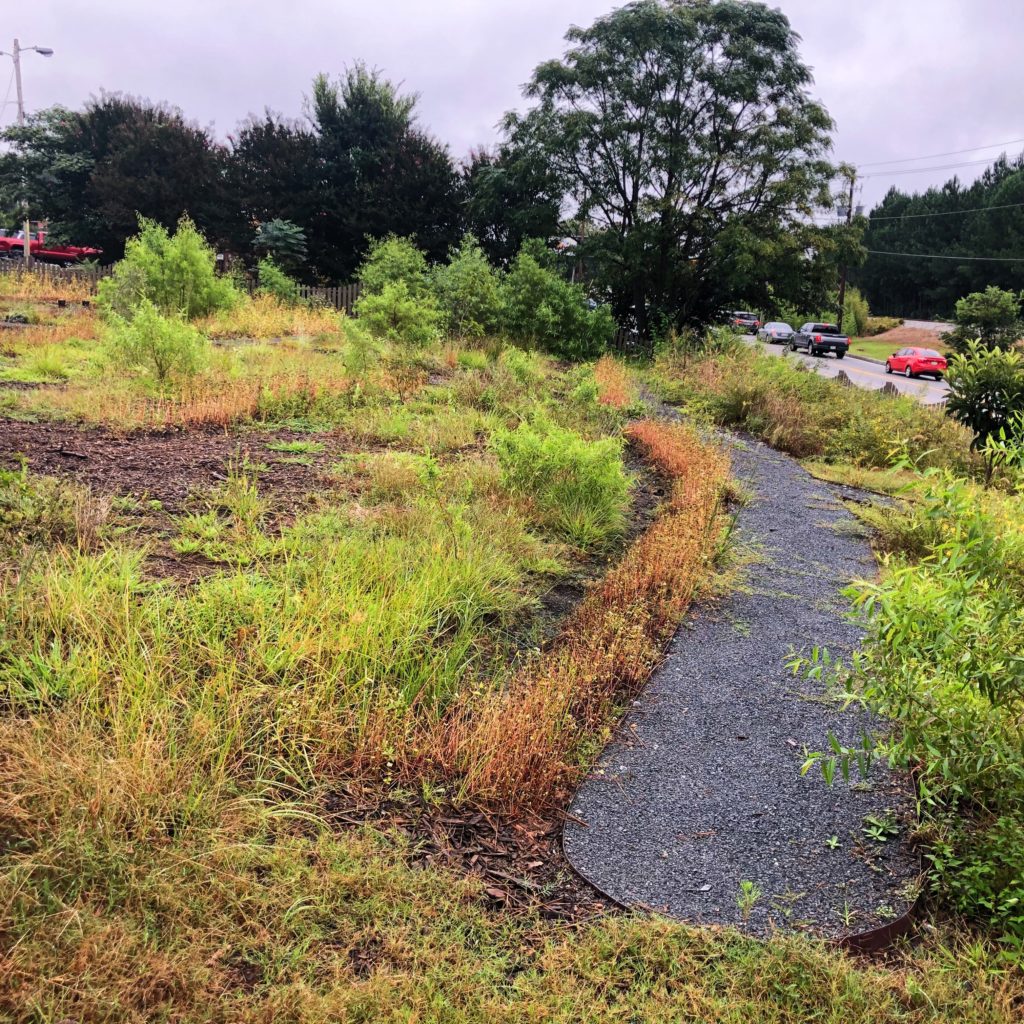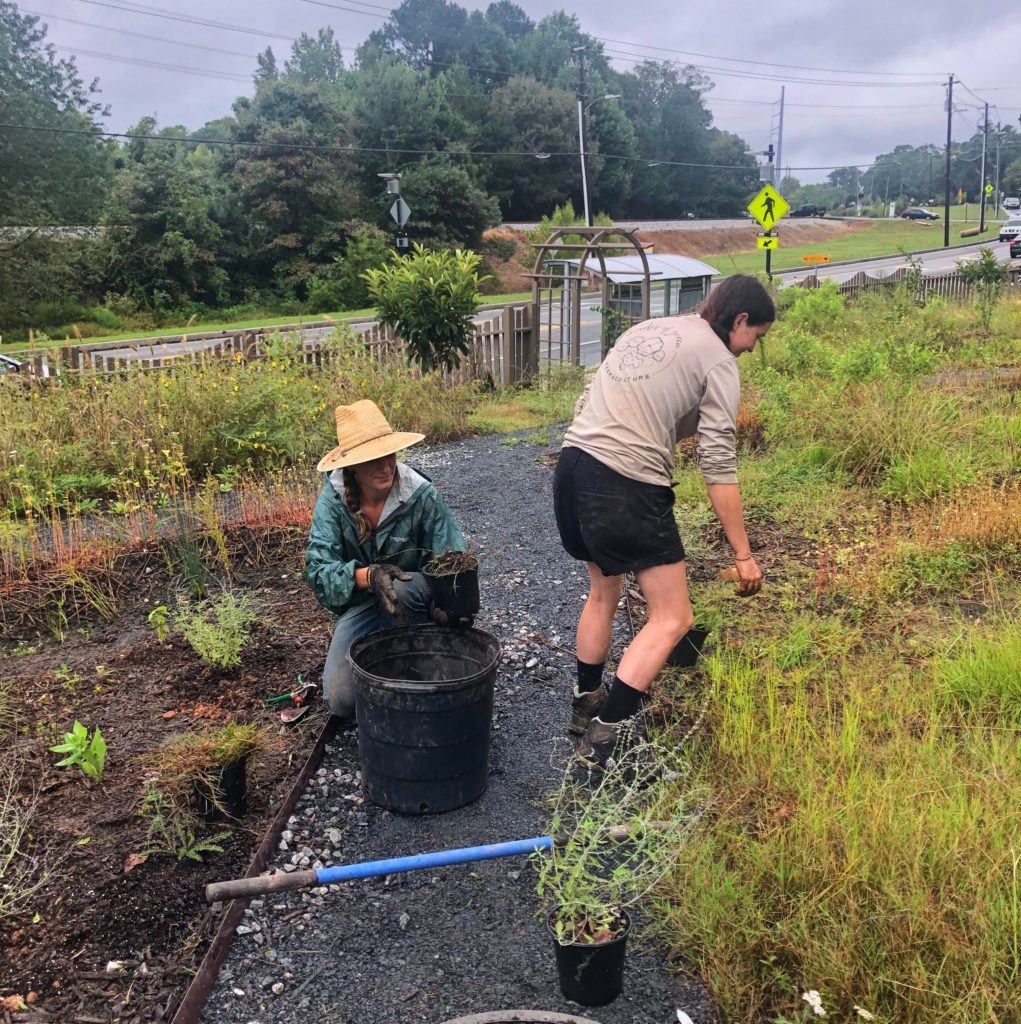
Shades of Green Caretaking Manager Roxann Drew leads the continued transformation of this municipal storage site into a productive community landscape.
Historically, beyond the value of aesthetic appeal, many municipalities have struggled—and still do—with how to prioritize, or even rationalize, investment in such qualitative, vision-based initiatives. It’s hard to quantify the value of a pocket park or community garden compared to the more concrete, revenue-based returns of traditional development.
Increasingly, though, we are seeing studies that tip the scales in favor of smart urbanism that emphasizes community impact and even ecologically-minded goals over those motivated by economics alone. Data that supports the economic value of various greenspace initiatives continues to emerge, too. So when a city expresses interest in developing a municipal site into a productive, regenerative landscape, we’re always excited to answer the call. And that’s just what we did when the City of Clarkston made the innovative decision to start transforming select municipal sites into productive urban landscapes to benefit the community and environment.
Vision Versus Reality
Every idea starts with a vision. Representatives from the City of Clarkston first contacted us with a particular site in mind. They were interested in assistance with the installation and management of their plan for transforming a triangular streetside space at the busy intersection of Brockett Road and East Ponce de Leon Avenue into a usable public space. This particular site previously served as a storage location for heavy equipment. The site is directly adjacent to MARTA public transit bus stop and is located across the street from a number of newer apartment complexes and quite close to a local pub. In theory, its convenient, high traffic location made it a perfect candidate for an ecologically-minded reimagining to boost local curb appeal and benefit public transit patrons, residents and visitors within walking distance.

The Brockett Triangle site in the City of Clarkston benefits nearby residents and public transit patrons.
However, the reality of what it takes to transform municipal sites like this into legible and productive public space isn’t nearly as simple as it might seem. In this location specifically, poor quality urban soil and water management issues were made worse by years of compaction from heavy equipment and ongoing development nearby. Inherently, municipalities and their public works teams also face additional challenges that can create obstacles to the implementation and maintenance of designs and plantings that fall outside conventionional landscaping know-how. Having been on the city council of Pine Lake, GA for over 5 years, I can empathize. But these challenges are precisely what make working with public lands and entities exciting! And at Shades of Green, we’re well-versed in bridging the gap between conventional and regenerative practices through iterative design and an ongoing consultative approach. Ultimately, the pros of creating productive public lands far outweigh the cons (read: challenges), and following the proper process will ensure project success.
The Cons:
- Iterative process—Whether it’s site prep like building healthy soil through composting, cover-cropping, creating earthworks and more, building a successful regenerative landscape takes time and ongoing observation. Unfortunately, current contractor bidding for most municipalities is not conducive to iterative processes. Greater flexibility in the bidding process is required to allow for increased adaptability and flexibility for innovative projects.
- Upfront investment—Sometimes, the activities or inputs needed to establish the foundation for long term success at disturbed or neglected public sites might require greater expenditure to start.
- Potentially forgo immediate gratification—Particularly when planting seeds and perennial plants during the ideal season, it’s possible that immediate gratification just won’t be possible as plants take time to establish, spread, bloom and change color.
- Additional workforce training may be required—A workforce trained in conventional landscaping practices may be unfamiliar with native and perennial plants and regenerative landscaping techniques involved in building soil and managing resources. If public works employees are intended to manage public lands, they may require assistance or further training to differentiate beneficial plants from weeds and successfully maintain landscapes regeneratively.
The Pros:
- Iterative process—The more iterative process of building a regenerative landscape allows for greater agility and nimble response to accommodate constantly-evolving plans, budgets and changes in municipal leadership.
- Long term savings—Regenerative landscapes can be more cost effective to establish and maintain. By building soil fertility naturally over time, selecting species suitable for the site and planting at the ideal time, the need for irrigation, costly inputs like synthetic fertilizers and continuous maintenance like mowing and blowing is decreased, saving time and money over time.
- Build community—Productive urban landscapes create opportunities for communities to gather, engage and build relationships.
- Produce food and medicine—When designed with food and medicine production in mind, productive urban landscapes can increase access to fresh food and medicine.
- Increase value—As density and cost of living increases, people are prioritizing places with productive, aesthetically-pleasing public landscapes and nature-based assets when considering their investment, and existing residents are increasingly demanding smarter use of underutilized public space.
A Regenerative Landscaping Journey
Regenerative landscaping is a journey. It may sound cheesy, but it’s absolutely true. It requires patience and a little bit more of an iterative approach than many municipalities and their teams might be used to, or equipped to do. But as representatives from cities and towns work to add value to their communities and respond to increasing constituent demand for interactive and environmentally-friendly greenspaces, this highlights the opportunities that exist for innovative collaboration, community engagement and ongoing workforce development.
We were inspired by the City of Clarkston’s initiative, and were excited to take part in their vision for creating a productive landscape. It was clear that to achieve their long term goals, and especially to manage the high volume of runoff water that this site experiences, the first step in the process would need to focus on building healthy soil. A fact I came across in a recent New York Times piece illustrates the importance of this process well: a 1 percent increase in organic matter alone can hold an additional 16,500 gallons of water per acre. So after the initial installation, we have continued to work with the City to make the necessary soil amendments to set the site up for future success. After adding a number of tons of compost and cover-cropping, we’ve established a tiered system of swales and berms to infiltrate water further.

Swales and cover-cropped berms serve to manage runoff and build healthy soil at the Brockett Triangle site while plantings for expanded edible landscaping and pollinator habitat becomes established along pathways and access points.
As work at the site progressed and collaborative planning with the City continued, another important point of discussion arose: planting and species selection. Conventional landscaping protocols in municipalities and public works departments often place heavy emphasis on commonly available annuals, which are installed for immediate color and replaced seasonally. While beautiful, more often than not these species create a high-input, high-care scenario dependent on synthetic fertilizers, ongoing irrigation and frequent replacement. But breaking from convention by integrating more perennials into designs at the onset can benefit municipalities. Although at times this might mean diminished aesthetic gratification upon planting, focusing on installing perennials first helps foster increased soil stability and fertility on site while creating lower management and costs in the long run. It also emphasizes an opportunity for continued education and training within public works departments. With consideration to the benefits of incorporating more perennials and native plants into landscaping at public sites, training public works employees to recognize ‘new’ species of plants, including trees and shrubs, will empower them to successfully manage these productive public assets moving forward. We recently worked with the city of Avondale Estates, GA to assist their public works employees with native plant identification and management at their lake.
The Journey Continues
After executing soil-building activities and installation during the initial phase of the Brockett Triangle transformation, we are thrilled to continue collaborating with the City of Clarkston at this site and others, like the streetscape surrounding Refuge Coffee. Led by our Caretaking Manager, Roxann Drew, Shades of Green is carrying the vision forward. The Caretaking Team has been indispensable in assisting with the next iteration of the project by creating a landscape and resource management plan that preserves and expands important pollinator habitat, increases plant health and establishes new plantings of native and edible species for beauty, food and medicine. Through their educational approach with both city representatives and nearby residents, engagement in this exciting community space is gaining more momentum than ever. Productive urban landscapes provide towns and cities with an important opportunity to build community, increase quality of life and enhance economic value all at once. We’re excited to see more municipalities look to regenerative landscaping solutions and management techniques. If you’re in the area, take a stroll through the Brockett Triangle site yourself to take a peek at the progress and say hi!

Members of the Shades of Green Caretaking team work rain and shine to bring the City of Clarkston’s vision to life at this former municipal storage site.